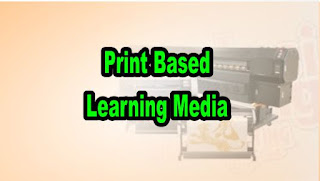Print Based Learning Media
Print-based learning media are material written on paper for learning and information. The most commonly known print learning media are textbooks, guidebooks, magazines and brochures. Print-based media demands 6 elements that need to be considered when composing namely format, organization, attractiveness, font size and use of spaces.
Format
1) If the paragraph is long, the one-column paper display is more appropriate, whereas if the short paragraph, the two-column paper display is more appropriate.
2) Different contents to be separated so as to attract the reader's attention.
Organization
1) Try to always inform students about their understanding in the text.
2) Arrange the text so that information is easy to obtain.
3) Boxes can be used to separate parts of text.
Attractiveness
Introduce each new chapter or section in a different way. this can motivate students to read on.
Font Size
1) Choose the font size that suits the student, the message and the environment.
2) Avoid using capital letters for the whole text because it can make the reading process difficult.
Space (Space) Empty
1) Use blank spaces that don't contain text or images to add contrast.
2) Adjust the spaces between the lines to improve the appearance.
3) Add spaces between paragraphs to increase readability.
Text or print based learning began to be known in the 1960s with the term programmed learning that contains material for independent learning. A teacher must strive to make this print-based material interactive (Arsyad Azhar, 2011).
The following are the types of print-based learning media: (Lestari, 2014)
1) Text book, is a book about a particular field of study or science that is compiled to facilitate teachers and students in an effort to achieve learning objectives.
2) Module, is a package of programs arranged in the form of specific units and designed in such a way that aims for the benefit of student learning. A module package usually contains a teacher instruction component, student activity sheets, work sheet keys, test sheets, and test answer keys.
3) Programmed Teaching Materials, is a package of individual teaching programs. Actually it's almost the same as a module, it's just that this programmed teaching material is organized into small topics for each frame or page. One frame or page usually contains information that is teaching material, questions, and feedback / responses from other frame questions.
Advantages of Print Based Learning Media
1) The subject matter can be designed as light as possible so that it can be captured easily by students.
2) The material can be repeated many times.
3) The combination of images and text can attract students' attention.
4) Can be produced economically
Lack of Print Based Learning Media
1) Difficult to display motion in the printed media pages.
2) Printing costs are more expensive.
3) The printing process takes a long time.
4) Cause a sense of boredom.
5) If not treated properly it will be easily damaged.
